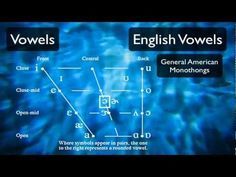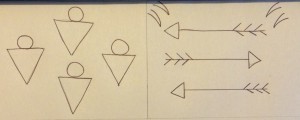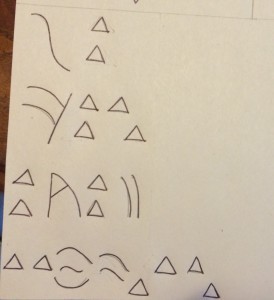Lost in Worldbuilding – Writing Systems
Welcome to Lost in Worldbuilding, where you witness the crazy things I’ll do to avoid writing while still pretending that I’m writing.
Here’s where I admit the embarrassing truth, that I am a conlanger.

I have around a dozen languages in various states of creation. Even worse, I have begun developing writing systems, runes, syllabaries and alphabets which the fictional people who speak my invented l anguages can write them. Or would, if they were real.
anguages can write them. Or would, if they were real.
Of all the ways I could possibly waste my time in worldbuilding, conlanging might be the biggest, at least to the level that I do it. According to most critic and editors, conlangs don’t belong in my novels. That hasn’t stopped me from putting them in there, and I know plenty of readers, including myself who love seeing invented languages in writing. But based on the number of critiques I’ve received telling me these made up words were distracting, annoying and pointless, I believe I’m in the minority.
A lot of language conflict can be conveyed without using made up words, and certainly without inventing whole lexicons and grammars. But designing languages appeals to the part of my brain that wants to understand how things work. It’s nitty gritty, and fun, working out the sounds, the words, their meanings. Figuring out how a single word comes to mean many different things. Developing grammar, function words, word order, rules about how verbs, nouns and adjectives change to fit into a sentence. And then figuring out all the fantastic conflicts that can arise from two people who speak different languages try to converse.
Insanity, truly. But I love it. Words, speech, language; it’s an art form.
If language is aural art, then writing is visual. Here is the same sentence (give or take) written in my three biggest languages from the Threads of Magic series; Yois, Skaod, and Bok Sa, in their respective forms of writing.

Mameoch tosan! Roughly translated, it means “we go to war!”
The Yois have an alphabet similar to ours, with about two dozen letters. Around a hundred years ago in Yois history, spelling was standardized.

Many at war.
The Yurha use a pictograph system, with pictures also representing certain sounds, in order to spell out words. Men and women who live through the current conflict happening in Kerila will likely get something like this tattooed on their arms. These pictographs are also written into wood, metal and rock.

Je sui emen oksyui! More directly translated, “go we to war.”
Nietza’s alphabet has a nearly 300 letters, heavily paired down from the syllabary their ancestors brought from across the ocean. The vast majority are consonants, which are the more decorative letters. The relatively few vowels used in the alphabet are represented by a pair of triangles in various positions. Pictured above is more common, informal writing. Formal writing used in government, religious texts and engravings, is much more complex, and difficult to read without years of study.
I hope you enjoyed this little peek into my favorite way to kill time. What do you do to avoid what you should be doing  Cheers!
Cheers!
S.M. Pace's Blog
- S.M. Pace's profile
- 8 followers



